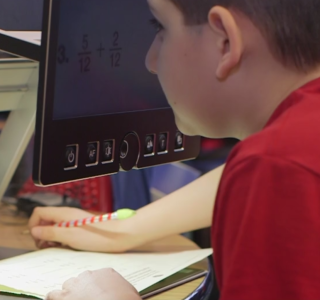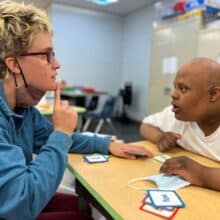
Where Do Children Who Are Blind or Visually Impaired Go to School?
June 4, 2015
“So do you go to a special school?” I remember being asked this question all the time as a child. Although special schools for the blind do exist, many children who are blind or visually impaired in the United States now attend public schools, just like any other child. Still, there are children that might benefit best from attending specialized schools for part or all of their education. This column is not meant to persuade readers on which school setting is better. It is only meant to give information on the various types of education settings that are available to blind and visually impaired children in the United States.
Regular Public School
The Individuals with Disabilities Education Act (IDEA) of 1975 guarantees an education in “the least restrictive environment.” This means that children with disabilities are entitled to a free education in the public school system, just like their non-disabled peers. IDEA was reauthorized and revised in 2004. For a child who is blind or visually impaired, this means that he or she can go to a local public school with his or her sighted peers. The student should also be provided with the necessary tools and support system to learn and participate in the classroom. These tools and support are primarily provided in three ways.
- Classroom for Students with Visual Impairments
Some districts provide a special classroom staffed by a teacher of the visually impaired. Depending on their needs, students may be in this classroom for part or all of the day. They will often be here to learn things such as independent travel, Braille and assistive technology. In some cases, they might also be in this classroom to learn academic subjects. However, the majority of students with visual impairments will attend the regular classroom for these lessons. Not all districts provide this classroom, however, so in many cases children will have to be bused to schools outside their neighborhood.
- Resource Room
If a student is primarily in regular (or mainstream) classes, then he or she will most likely go to a resource room for part of the day. Students might come to this room to learn how to use assistive technology, or to complete academic assignments requiring the use of specialized materials or devices. Unlike classrooms for children with visual impairments, resource rooms serve students with various types of disabilities and are found in many districts.
- Regular Classroom
Many students with visual impairments attend their local school districts along with their sighted peers. They will receive specialized instruction related to their visual impairment from an itinerant teacher of the visually impaired, who works one-on-one with each student. These teachers travel to different schools, and work with students either in the regular education classroom or in a separate room. They may teach students how to read and write Braille, use special technology and other techniques or strategies for completing school assignments. The time spent with each student varies depending on the child’s individual needs.
Specialized or Residential Schools for the Blind
Most states have specialized schools for children who are blind or visually impaired. While the majority of blind and visually impaired children attended these schools in the past, nowadays they primarily serve students with additional disabilities. Schools for the blind are often residential and serve students from throughout the state where they are located. They provide many specialized services, such as Braille and assistive technology lessons, instruction in orientation and mobility and occupational and physical therapy. Some students in these schools might even attend the local public school to participate in mainstream classes.
Deciding where a blind or visually impaired child goes to school depends on many factors. There are pros and cons with all types of settings, and it is up to the child’s parents and teachers to determine the best placement. Some factors that should be considered include the child’s goals, available services and programs in his or her home district, services he or she needs the most, among other things. Parents should do as much research as possible about their home district and specialized schools in order to decide what is best for their child. No matter the decision, the overall objective should be for the child to receive the education and services that will best meet his or her needs.
For a more in-depth look at the various education settings for children who are blind or visually impaired, visit FamilyConnect’s website. As always, please share your thoughts and experiences with us! You can send questions related to blindness or visual impairment to sandysview@chicagolighthouse.org.






